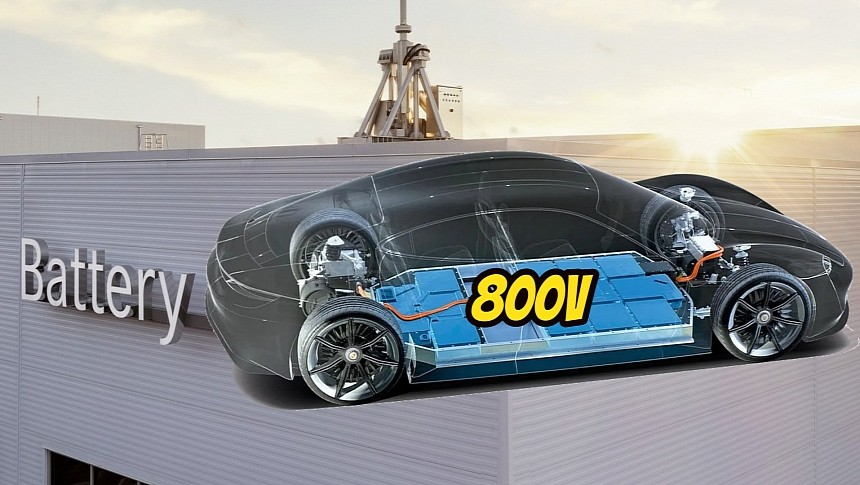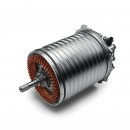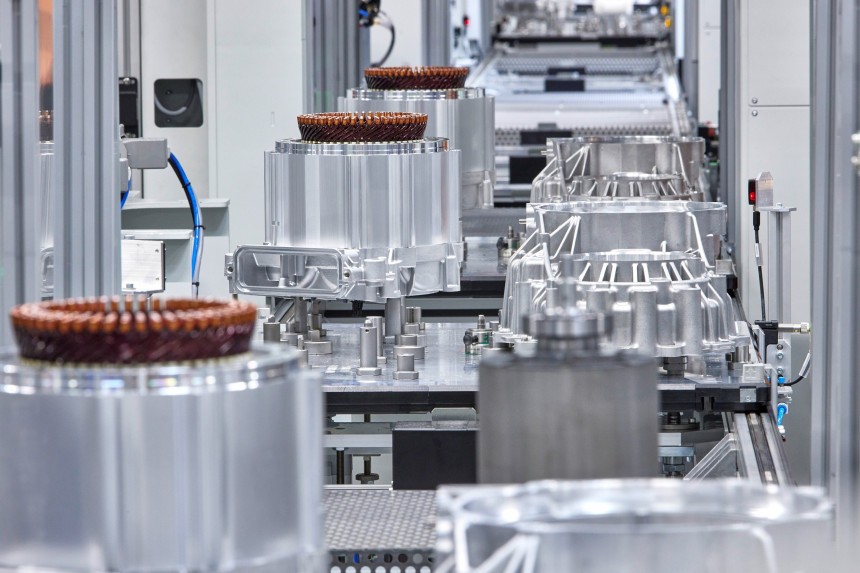Auto parts manufacturer Bosch confirms the start of volume production of electric motors and inverters boasting 800V technology. This type of EV powertrain can help automakers make their mobility products more efficient and give them improved fast-charging capabilities. Here's the gist of it.
Today's all-electric cars have motors, high-voltage batteries, and auxiliaries that run on the 400V architecture. Tesla's newest units sit somewhere between 500V and 600V (and can fast-charge at up to 250 kW). At the same time, other brands like Porsche, Lucid, Hyundai, and Kia already have zero-tailpipe emission units on sale with 800V technology.
That advantage allows them to replenish their energy storage units faster at DC fast chargers that can dispense electrons at a rate of 350 kW tops. The Lucid Air, for example, is the world's fastest-charging EV available to consumers today.
Bosch's incursion into the 800V architecture territory comes at the right time. Auto brands want their EVs to charge faster and be more efficient. The German company already supplies the power units used on the quad-motor Rivian R1T and R1S. It could expand that partnership if it reaches a great deal with the Irvine-based automaker.
It's worth noting, however, that Rivian started developing its own 800V architecture. But for the time being, that technology seems to be reserved for the upcoming R2-series vehicles. The R1T and R1S could be moved onto a more potent platform after the cheaper and smaller models are officially introduced and enter production. But for now, both units will remain on the 400V architecture.
Bosch's solution comprises an inverter with silicon carbide semiconductors that improve efficiency, while the motor boasts more power density. These two novelties make the entire power unit lighter and smaller. The company claims that "a premium German automaker" has already encompassed the rotor and stator into an unnamed vehicle's powertrain.
Going from 400V to 800V means the current remains unchanged, but the power transmitted through thinner cables can double. That brings down manufacturing costs for the automaker and improves the lifetime of the powertrain because of less heat loss in the charging process.
Electrical current represents the flow of electrons and protons, while electricity is about energy or the flow of energy between the previously mentioned charged particles.
The auto parts giant says its 800V solution can, in theory, allow EVs to charge at speeds of up to 500 kW. Mercedes-Benz recently announced that its new high-power charging station could enable all-electric cars to replenish their energy storage units at rates of up to 400 kW. We're slowly but surely heading in the right direction. Battery-electric automobiles could end up needing just 10-minute charging sessions to add around 200 miles of range.
However, keep in mind that current EV drivetrain technology means cars have charging curves. The more you "fill" the battery with electrons, the slower it will charge because of the pack's resistance.
For example, the mighty capable Lucid Air takes full advantage of a 350 kW DC fast charger until it reaches approximately 25% state of charge. From there onwards, the rate at which it sucks energy from the grid slowly decreases. On top of that, if the battery wasn't preconditioned in advance, it could need more energy to allow the thermal management system to keep everything at the right operating temperature.
Lastly, Bosch's new 800V motor has a power output of 617 hp (460 kW) and 613 lb-ft (830 Nm) of torque.
That advantage allows them to replenish their energy storage units faster at DC fast chargers that can dispense electrons at a rate of 350 kW tops. The Lucid Air, for example, is the world's fastest-charging EV available to consumers today.
Bosch's incursion into the 800V architecture territory comes at the right time. Auto brands want their EVs to charge faster and be more efficient. The German company already supplies the power units used on the quad-motor Rivian R1T and R1S. It could expand that partnership if it reaches a great deal with the Irvine-based automaker.
It's worth noting, however, that Rivian started developing its own 800V architecture. But for the time being, that technology seems to be reserved for the upcoming R2-series vehicles. The R1T and R1S could be moved onto a more potent platform after the cheaper and smaller models are officially introduced and enter production. But for now, both units will remain on the 400V architecture.
Bosch's solution comprises an inverter with silicon carbide semiconductors that improve efficiency, while the motor boasts more power density. These two novelties make the entire power unit lighter and smaller. The company claims that "a premium German automaker" has already encompassed the rotor and stator into an unnamed vehicle's powertrain.
Electrical current represents the flow of electrons and protons, while electricity is about energy or the flow of energy between the previously mentioned charged particles.
The auto parts giant says its 800V solution can, in theory, allow EVs to charge at speeds of up to 500 kW. Mercedes-Benz recently announced that its new high-power charging station could enable all-electric cars to replenish their energy storage units at rates of up to 400 kW. We're slowly but surely heading in the right direction. Battery-electric automobiles could end up needing just 10-minute charging sessions to add around 200 miles of range.
However, keep in mind that current EV drivetrain technology means cars have charging curves. The more you "fill" the battery with electrons, the slower it will charge because of the pack's resistance.
For example, the mighty capable Lucid Air takes full advantage of a 350 kW DC fast charger until it reaches approximately 25% state of charge. From there onwards, the rate at which it sucks energy from the grid slowly decreases. On top of that, if the battery wasn't preconditioned in advance, it could need more energy to allow the thermal management system to keep everything at the right operating temperature.
Lastly, Bosch's new 800V motor has a power output of 617 hp (460 kW) and 613 lb-ft (830 Nm) of torque.










